| | Tech Tips - Business IT Support Tips
Posts Tagged ‘hard drive’
Saturday, November 26th, 2011
A hard drive is a small box inside of computer equipment that may contain sensitive information such as usernames, passwords, credit card information, social security numbers, etc. If you are upgrading to a new computer (desktop computer, laptop, office copier, etc.) always remove and destroy the hard drive before selling, donating, or recycling any computer equipment! Failure to destroy the hard drive before giving the computer away could result in sensitive information ending up in the hands of the new owner, who will then be able to copy old files and go through your personal information stored there.
There are many options available if you are looking to dispose of an old hard drive. Some professional destruction methods include:
- Shredding it using a local shredding company
- Taking it to a computer recycling company
- Mailing it to a hard drive destruction specialist
- Bringing it in to a local computer shop that will dispose of it
These methods are ideal, but they usually cost money. Professional destruction of a hard drive could cost $70 or more in some areas! So what is a low cost method to dispose of the hard drive and keep your personal data safe if you are low on funds? Considering you have all the right tools, this method won’t cost you a dime and is a very secure way to get rid of a hard drive while keeping your data secure.
Step 1: Wipe it! Wiping a hard drive in essence destroys the data by writing over it with random characters. There are many free utilities to help, a good one is Active@ KillDisk. You can download the free utility from their website, click: Active@ KillDisk. This free software overwrites all of the data on your old hard drive with random characters and WILL DESTROY ALL OF YOUR DATA! Be sure you have performed a complete backup and have transferred the data from your old hard drive to your new system before wiping it.
Step 2: Remove it! Physically remove the hard drive from the system. This is usually the easy part, you’ll just need a screwdriver and a little patience. Keep in mind that you will still be able to sell or donate the old computer without a hard drive missing, just be sure to let the new owners know in advance that they will need a new hard drive and operating system.
Step 3: Drill it! If you plan on using the old hard drive again, skip this step. Otherwise it’s best to physically destroy the old hard drive just to be 100% certain that the old data is completely destroyed. This step is not only fun, depending on how much personal data you had on the old drive it can also help you sleep better at night.
Wearing protective goggles, gloves, and a dust mask for your mouth and nose take a drill and a metal drill bit to the drive. You’ll want to drill through the drive completely from one side to the other, and you’ll want to do this multiple times. Two important areas for you to drill through are the platters and the controller board. See examples in the below images.
-
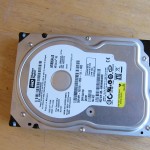
-
Hard drive from an old computer, data already moved to new computer and ready for destruction.
-
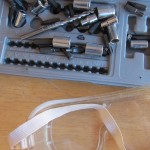
-
A few things you should have. Drill bits, eye protection, gloves, mouth and nose protection.
-
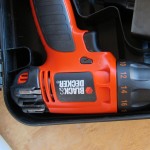
-
A drill
-
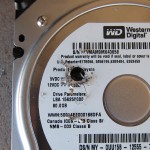
-
Hard drives contain many round platters inside that store the data. Drill through them.
-
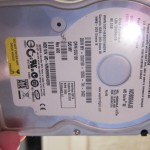
-
In this example, the drive has been drilled through one side to the other. You can see the light behind it coming through.
-
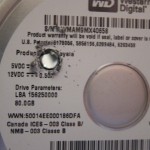
-
Close up of the hole drilled through the hard drive
-
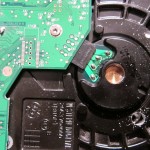
-
The green area is the controller board. Drill through that as well.
-
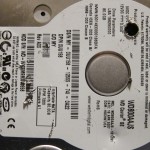
-
Don’t stop with just one hole, drill several times through the drive.
-
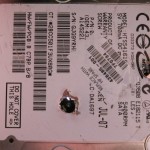
-
The last hard drive was a 3.5″ desktop drive. You can drill 2.5″ laptop hard drives the same way.
-
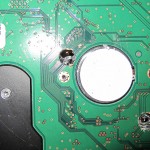
-
This laptop hard drive has a much larger controller board on the bottom, but is easier to drill through.
-
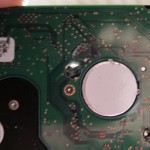
-
Multiple drill holes through a 2.5″ laptop hard drive
All done!
>> Did you like this article? Ping it!
Tags: backup, characters, cheap, computer, computer shop, controller board, copier, data, desktop, destroy, destroy the hard drive, destruction, dispose, donating, drill, easy, free, gloves, googles, hard drive, hard drive destruction, information, killdisk, laptop, low cost, mask, metal drill, method, new computer, old data, overwrite, passwords, personal data, physically destroy, platters, random, recycling, remove, secure, selling, shredding, tools, upgrading, wiping, writing
Posted in Tech Club General | No Comments »
Thursday, June 16th, 2011
Can you remember when you last backed up the data on your computer or your server?
Most people reading this article will not have a quick answer because most people do not have an established backup plan in place. However, lack of a backup plan could turn into a real problem for you down the road. Think about what you might lose if you lost your computer in a fire or your hard drive suffered a catastrophic failure. You might lose family pictures and videos, important financial and tax information, music collections or worse. At my PC Techs we have heard and experienced many horror stories about individuals losing an entire lifetime of converted images, home videos, and financial documents. We have been contacted by business owners that have had to close their doors and stop all production because they experienced a server hard drives crash and had no reliable backup to restore it from.
If you’re scrambling to find out how to perform data backups, don’t worry. It can be very easy to produce and secure a reliable backup. First, you’ll need to purchase an external hard drive. External hard drives with USB or Firewire connections are available online, at local computer stores, and even in most large office supply stores. Western Digital and Seagate make reliable external drives to use for backup and come recommended for their reliability. If you’re uncertain as to what hard drive to purchase, it is a good idea to look at reviews and to find recommendations from others. A good resource for hardware reviews and to purchase external hard drives online is Newegg, http://www.newegg.com. Also, when you select a backup device, be sure to locate one that has enough space for all of the hard drives on your system.
Some external hard drives come bundled with backup software, but we caution you against using that software to perform a backup as most of these programs do not have an option for full partition or full disk backup. A full partition backup is critical when you need to recover from a system failure in a hurry. We recommend that you download and install a free* software tool called Easeus ToDo Backup. After installing Easeus, look for the backup option named full disk & partition backup & restore. Support and instructions on the use of Easeus Todo Backup can be found in the Support section of the site linked above. Perform a complete system backup of your entire computer, including all hard drives, to the external hard drive.
Once you’ve performed a full disk backup using Easeus, you should check that the job completed without error and confirm that you have a full and complete backup of your data. Some of those horror stories we talked about earlier were from people who presumed that everything was fine with their backup when in fact it was not. Errors and problems can occur with backup software just like anything else. Be sure to check your backups on a regular basis and ensure that they are complete. For additional data protection, consider purchasing a second external backup hard drive and using that to rotate backups. Store the second backup drive at a separate physical location from the first, to protect against theft or fire.
*Easus ToDo Backup is free for home use only. Small & medium business workstations and server versions require an additional payment.
>> Did you like this article? Ping it!
Tags: backup, data, easeus, external, hard drive, usb
Posted in my PC Techs News & Events | No Comments »
Sunday, September 19th, 2010
How old is your existing computer? Did you purchase it longer than three or four years ago? If you haven’t purchased a new computer for yourself, new servers, or new systems for your office, it’s time to take a good look at what’s available! Technology has advanced considerably over recent years and prices have come down at the same time. There are some amazing deals available out there for system upgrades.
Take the Dell Optiplex 780, for example. Here are a few specs from a mid-range Dell system selling for only $750. But don’t let the mid-range category fool you, compared to older computers this is a beast!
- Windows 7 Professional
- Intel® Core™ 2 Quad 2.6 GHz Processor
- 4 GB System Memory (RAM)
- 160GB 7,200 RPM SATA, Hard Drive
Now, let’s compare this to a very popular system being sold by Dell in 2006 for around the same price range, the Dell Dimension 3100. These systems were very popular, and we still run across many offices with these systems still running today. How does it stack up to the Optiplex 780? Here are some specs from the 3100:
- Windows XP Professional
- Pentium 4 3.0 GHz Single Core Processor
- 512 MB System Memory (RAM)
- 80GB Hard Drive
The processor on the older 3100 system took 231 seconds to do the same office task that the new 780 system can do in only 114 seconds. Also keep in mind that the new 780 has FOUR cores, and that same task can be performed four times in the same span of time as the 3100 is cranking away on a single task. WOW, now there’s an amazing difference. This is the type of productivity increase that should not be ignored. With every computer in an office running tasks twice as fast, and capable of running 4 times as many tasks at once, it’s easy to see how an entire company can realize a massive jump in productivity after a minimal investment in new computer systems.
Some other benefits: Windows 7 is far more stable than Windows XP, which means fewer crashes and less troubleshooting to contend with. Also, any time a new system is setup and configured, you have an opportunity to clean out old junk files from the previous system that have been slowing you down. There’s also an opportunity to install the latest anti-virus and make sure that software is configured correctly for optimal performance. Finally, let’s not forget about Office 2010. If you’re upgrading computers, it’s probably a good idea to dump that old version of Office 2003 and get the latest and greatest, Office 2010. This software is packed with new features that make it easier and faster to compose and share documents.
The same increase in productivity, speed, and reliability also carries through to the latest laptops and servers on the market. New office technology is very affordable right now and will work wonders for any office of any size. We can help you pick out and customize the system that is right for you. Several important factors to consider include type of processor, hard drive size, network card, and operating system depending on where and how you will use the computer.
When deadlines matter and competition is tight, it’s important to provide yourself and your employees with the latest tools if you want to be successful. Let my PC Techs provide your office with a free, expert consultation. We can help you identify the best use of your yearly technology budget to make meaningful purchases that will increase productivity and save time and money. Call (602) 456-0150 to setup your free consultation today.
Tags: 2006, 3100, 7200 RPM, advanced, affordable, and everything, anti-virus, Arizona, available, budget, clean, company, compare, competition, computer, computers, configuration, configured, consultation, Core 2, cores, crashes, deadlines, deals, Dell, difference, dimension, drives, employees, expert, factors, fast, GB, greatest, hard drive, help, install, Intel, investment, jump, junk, laptops, latest, memory, mid-range, network card, networks, new computer, office, office 2003, office 2010, old, older, operating system, Optiplex, packed, pentium 4, phoenix, pick out, popular, ports, prices, Processor, productivity, purchase, purchased, purchases, Quad Core, RAM, right for you, running, SATA, seconds, servers, setup, slowing, software, specs, stable, system, systems, task, tasks, technology, technology built in, tools, troubleshooting, upgrades, upgrading, windows 7, windows XP, years
Posted in Tech Club General | No Comments »
Saturday, September 18th, 2010
 We do work for several restaurants and retail stores here in Phoenix, Arizona. These shops are all using windows based point of sale systems. While the software and database that run on the computers to transact credit card payments and process menu items are highly customized and supported by the franchise in most cases, the underlying operating system and hardware is not. We do work for several restaurants and retail stores here in Phoenix, Arizona. These shops are all using windows based point of sale systems. While the software and database that run on the computers to transact credit card payments and process menu items are highly customized and supported by the franchise in most cases, the underlying operating system and hardware is not.
We have learned a lot about these systems and can say with certainty that the biggest issues we have run into are lack of proper backups and lack of spare hardware. When a point of sale system goes down for a store, especially a busy store, it is NO FUN. Employees need to process payments manually by hand and write out paper receipts. As you can imagine, the slowdown at the register does a lot to aggravate customers and employees alike. But there are three things that you can do as a retail store business owner to minimize downtime in the event of a system crash.
1. Perform regular system maintenance
Hiring a firm like my PC Techs to regularly maintain your equipment each month can save you from several hours worth of headache and hundreds or thousands of dollars in lost sales. Our technicians will visit your store and examine your systems for irregular performance. System errors, faulty hardware, failing hard drives, botched OS updates, and corrupted data can, in many cases, be identified and corrected before it becomes a larger problem. Dust can be cleaned out (the largest cause of hardware failure), and parts inspected. Unnecessary programs can be removed and system performance improved. The best part of this scenario, the repairs can be performed before or after regular hours, so customers never experience delay.
2. Perform regular, complete data backups
Usually during the same time as the system maintenance, our technicians can perform a complete data backup of all of your POS systems. This is important. When a hard drive crashes, you want to get your system back online as quickly as possible. To rebuild an entire system, restore data from on off site repository, and get all the hardware and software working correctly could take many hours. With a complete system backup, it could be as simple as popping in the right piece of replacement hardware and running a 30 minute recovery.
3. Identify and build an inventory of replacement parts
When a system failure happens, recovery time can be improved considerably when the right spare parts are kept on hand. Rather than buying hard to find computer equipment online, and waiting for it to be shipped, a replacement part can be obtained from storage and quickly installed to replace the broken component. That part can later be replaced to storage, so you always have a backup on hand for the next time disaster strikes.
When you think about the security of your data and your ability to transact business, keep in mind your local computer experts and ways that they can work with you to help improve the reliability of your computer operations. For help with the maintenance and emergency support of your POS systems, contact my PC Techs today. (602) 456-0150.
Tags: Arizona, backup, backups, based, business, business owner, buying, cleaned, clients, computer, computer equipment, computer experts, computers, corrupted, credit card, customers, data, data backup, database, delay, disaster, dollars, downtime, dust, employees, equipment, errors, failure, faulty, franchise, goes down, hard drive, hard drives, hard to find, hardware, headache, hours, improve, improved, inspected, issues, maintain, maintenance, menu items, minimize, month, my pc techs, online, operating system, operations, OS, parts, payments, PC, performance, phoenix, point of sale, pos, problem, process, programs, projects, rebuild, receipts, recovery, register, reliability, removed, replacement, replacement part, restaurants, restore, retail, retail tores, sales, security, shipped, software, spare, storage, store, system, system crash, system maintenance, systems, technicians, transact, windows
Posted in Tech Club General | No Comments »
Wednesday, September 8th, 2010
Can anyone name a small business, or any business for that matter, that doesn’t rely upon technology for day to day operations? Computers play such an integrated role in our lives. Much like automobiles, it is important to maintain your computers and run periodic checks on them to avoid failure.
When doing routine system maintenance, there are several different areas of the computer that should be checked for potential problems. The operating system itself, installed software, updates and patches, anti-virus definitions, the network settings, the system fans, dust levels, hard disk drives, backups, and external devices! Some are more important than others. For example, if your hard drive fails, you could face some very costly data recovery issues. Dust is another one, dust and heat are the biggest killers of electronic components. A competent computer repair firm will have a checklist of items that a technician will run through, the hard drive and dust levels being just one of those, to ensure optimal performance.
Not to get stuck on the automobile analogy, but it’s so easy to do comparisons between that and computer repair. If you forget to change your oil, over time your engine suffers. If you go long enough, eventually your engine will fail. Computer maintenance is the same way. A lot of clients have come to us with failed hard drives. Sometimes we can get their data off pretty easily and recover their systems. In the worst cases, those hard drives need to be sent off to a lab where data recovery becomes extremely costly. Client with crashed hard drives are usually surprised when we tell them that the crash could have been avoided. There are warning signs that most equipment will give when things go bad, and the signs usually begin a while before the actual crash takes place. For hard drives, it could be slow performance, errors while working, errors in system logs, or even clicking or grinding sounds. Most computer fans make noises too when they are about to fail.
Our experts service and repair machines and are experienced in the different ways you can identify computer problems. If you hire a team of professionals that know how to keep your computers working, and have them come out monthly for a quick checkup, you too will be able to keep working. For most people, computer failures usually happen at the worst possible time. Like, right before an important project deadline. If your computer suddenly crashes or the network is not working you may lose work and income. All of this could be avoided with just a couple hours of preventative maintenance per month.
>> Did you like this article? Ping it!
Tags: anti-virus, automobiles, avoid, backups, business, checklist, checks, checkup, clicking, clients, components, computer, computer maintenance, computer problems, computer repair, computers, costly, crash, crashed, crashes, data, data recovery, deadline, drives, dust, electronic, engine, equipment, errors, experts, external devices, fail, failed, failure, failures, fans, firm, grinding, hard disk, hard drive, hard drives, heat, hire, items, killer, lab, lives, machines, maintain, monthly, network, operations, patches, performance, problems, professionals, project, recover, rely, repair, role, service, settings, slow performance, small business, software, system, system logs, system maintenance, systems, team, technician, technology, updates, warning signs, working
Posted in Tech Club General | No Comments »
WE WORK HARD FOR YOU, BUT DON'T JUST TAKE OUR WORD FOR IT!
We've helped over 1,000 satisfied businesses throughout the Phoenix valley, click here to view some of their testimonials:

©2010 my PC Techs is owned and operated by Leo Polus, L.L.C., concept by Andre Morris |
| |












 We do work for several restaurants and retail stores here in Phoenix, Arizona. These shops are all using windows based point of sale systems. While the software and database that run on the computers to transact credit card payments and process menu items are highly customized and supported by the franchise in most cases, the underlying operating system and hardware is not.
We do work for several restaurants and retail stores here in Phoenix, Arizona. These shops are all using windows based point of sale systems. While the software and database that run on the computers to transact credit card payments and process menu items are highly customized and supported by the franchise in most cases, the underlying operating system and hardware is not.





